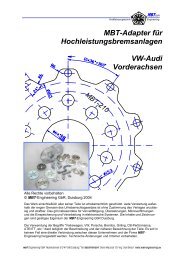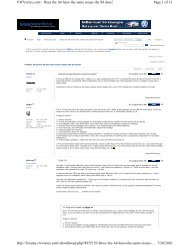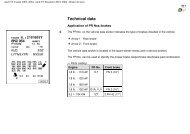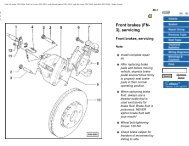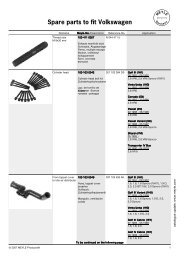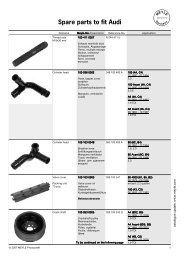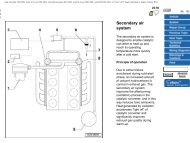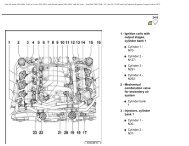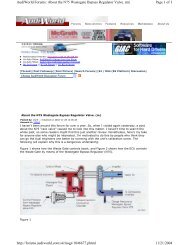VW MKII A2 MK2 Golf Jetta Fox Service Manual - VAGLinks.com
VW MKII A2 MK2 Golf Jetta Fox Service Manual - VAGLinks.com
VW MKII A2 MK2 Golf Jetta Fox Service Manual - VAGLinks.com
You also want an ePaper? Increase the reach of your titles
YUMPU automatically turns print PDFs into web optimized ePapers that Google loves.
18.13 Using a chain wrench to unscrew oil<br />
filter<br />
the oil filter, as described below, while the oil<br />
is draining.<br />
4 After all the oil has drained, wipe off the<br />
drain plug with a clean rag and on 1.6 and 1.8<br />
litre models, renew the O-ring. Clean the area<br />
around the drain plug opening and refit the<br />
plug. Tighten the plug to the specified torque<br />
setting.<br />
5 Depending on engine type, refer to the<br />
following sub Section and renew the oil filter.<br />
6 Remove the oil container and all tools from<br />
under the vehicle.<br />
7 Refill the engine with the specified type of<br />
oil. Pour in half the specified quantity of oil<br />
first, then wait a few minutes for the oil to<br />
drain to the sump. Continue adding oil a small<br />
quantity at a time until the level is up to the<br />
lower mark on the dipstick (see Weekly<br />
checks). Adding a further 1.0 litre will bring the<br />
level up to the upper mark on the dipstick.<br />
8 Start the engine and run it for a few minutes<br />
while checking for leaks around the oil filter<br />
seal and the sump drain plug.<br />
9 Switch off the engine and wait a few<br />
minutes for the oil to settle in the sump once<br />
more. With the new oil circulated and the filter<br />
now <strong>com</strong>pletely full, recheck the level on the<br />
dipstick and add more oil as necessary.<br />
10 Dispose of the used engine oil safely.<br />
Filter renewal<br />
11 On 1.05 and 1.3 litre engines, the oil filter<br />
is located on the front of the engine beside the<br />
alternator.<br />
12 On 1.6 and 1.8 litre engines, the oil filter is<br />
located on the side of the crankcase beneath<br />
the distributor. It is screwed onto a mounting<br />
bracket attached to the crankcase. On fuel<br />
injection models, an oil cooler is fitted between<br />
the mounting bracket and filter cartridge.<br />
13 With the engine oil drained, place a<br />
suitable container beneath the filter then,<br />
using a suitable tool, unscrew the filter (see<br />
illustration). Empty any oil in the old filter into<br />
the container and allow any residual oil to<br />
drain out of the engine.<br />
14 Check the old filter to make sure that the<br />
rubber sealing ring has not stuck to the<br />
engine. If it has, then carefully remove it. Wipe<br />
clean the sealing face on the cylinder block.<br />
15 Smear the sealing rubber on the new filter<br />
with clean engine oil, then fit and tighten the<br />
filter by hand only.<br />
Every 10 000 miles or 12 months 1•17<br />
19.2 Check exhaust system connections<br />
for leaks and security<br />
16 On <strong>com</strong>pletion, replenish the engine oil<br />
then wipe clean the filter body. When the<br />
engine is restarted, check around the filter<br />
joint for any signs of leakage.<br />
19 Exhaust system check<br />
1<br />
1 With the exhaust system cold, check the<br />
<strong>com</strong>plete system from the engine to the end of<br />
the tailpipe. Ideally the inspection should be<br />
carried out with the vehicle raised and<br />
supported on axle stands (see “Jacking and<br />
vehicle support”) to permit unrestricted access.<br />
2 Check the exhaust pipes and connections<br />
for evidence of leaks, severe corrosion and<br />
damage (see illustration). Ensure that all<br />
brackets and mountings are in good condition<br />
and tight. Leakage at any of the joints or in<br />
other parts of the system will usually show up<br />
as a black sooty stain in the vicinity of the leak.<br />
3 Rattles and other noises can often be<br />
traced to the exhaust system, especially the<br />
brackets and mountings (see illustration). Try<br />
to move the pipes and silencers. If the<br />
<strong>com</strong>ponents can <strong>com</strong>e into contact with the<br />
body or suspension parts, secure the system<br />
with new mountings or if possible, separate<br />
the joints and twist the pipes as necessary to<br />
provide additional clearance.<br />
20 Slow running adjustment<br />
4<br />
To check this adjustment, first determine<br />
which fuel system is fitted to the vehicle<br />
concerned and then refer to the appropriate<br />
Part of Chapter 4 for adjustment of that<br />
particular system.<br />
21 Clutch operation check<br />
2<br />
1 Check that the clutch pedal moves<br />
smoothly and easily through its full travel and<br />
that the clutch itself functions correctly, with<br />
no trace of slip or drag.<br />
1081 <strong>VW</strong> <strong>Golf</strong> & <strong>Jetta</strong><br />
19.3 Check exhaust system mountings<br />
2 If excessive effort is required to operate the<br />
clutch, check first that the cable is correctly<br />
routed and undamaged, then remove the<br />
pedal to ensure that its pivot is properly<br />
greased before suspecting a fault in the cable<br />
itself. If the cable is worn or damaged, or if its<br />
adjusting mechanism is no longer effective,<br />
then it must be renewed.<br />
3 Refer to Chapter 6 and on those models<br />
where it is possible, check that the clutch is<br />
correctly adjusted.<br />
22 Gearbox oil level check<br />
2<br />
Note: Gearbox oil can foam when hot and<br />
give a false level reading. Allow the gearbox to<br />
cool before checking the oil level.<br />
1 The gearbox oil level must be checked<br />
before the vehicle is driven, or at least 5<br />
minutes after the engine has been switched<br />
off. If the oil is checked immediately after<br />
driving, some of the oil will remain distributed<br />
around the gearbox <strong>com</strong>ponents, resulting in<br />
an inaccurate level reading.<br />
084 and 085 gearboxes<br />
2 Position the vehicle on level ground.<br />
3 The oil filler/level plug is difficult to reach<br />
using the normal hexagon key and it will be<br />
much easier to use a nut and bolt as shown<br />
(see illustration) together with a conventional<br />
spanner. Instead of welding a single nut on<br />
the bolt, two nuts may be tightened against<br />
each other using thread-locking fluid.<br />
22.3 Nut and bolt welded together to make<br />
oil level plug removal tool - 084 gearbox<br />
A Bolt M10 x 100 mm B Welded nut<br />
Arrows show area of weld<br />
1



